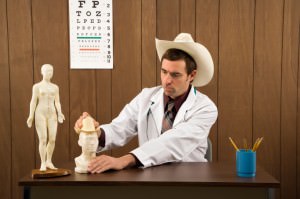Practicing Medicine in a Rural Context

The reality is that those living in poor urban settings and those living in rural settings are affected by physician shortages at a disproportionately high rate. It’s probably not surprising that those in a poor, urban context are less likely to have access to medical treatment. Poverty is a contributing factor to limited access to most all goods and services, and the lower payments offered by Medicare and Medicaid only compound the problem.
But the rural shortage may be something that you haven’t considered. About 20% of the U.S. population lives in rural areas, yet only 9% of America’s physicians practice in those same rural areas. Of the roughly 66 million Americans living in underserved areas, what the Department of Health and Human Services call Health Professional Shortage Areas (HPSAs), approximately 20 million of them live in non-metropolitan, or rural areas. Rural residents are four times more likely to live in an HPSA than those living in cities or suburbs.
Why the shortage in rural areas? Part of it is economics. There tend to be more people who are on Medicare and Medicaid in rural areas, and as the recovery from recession has been slow and protracted that number has swollen. This makes it hard for physicians who rely on those with private insurance to shore up what is lacking in the payments they receive from these federal programs. Many doctors report losing money on Medicare and Medicaid patients, so if that becomes the vast majority of your client base at some point the numbers just won’t add up.
But there are also demographic shifts. For one thing the developed countries are urbanizing everywhere. The trend is toward people moving to cities and metropolitan areas, and that goes for doctors too. Half of medical students who come from rural backgrounds say they don’t intend to go back. But that factor compounded by the fact that the baby boomer generation is aging, meaning more doctors are retiring than coming into the field and more people are reaching a point in life where they have increased medical needs, creates something of a perfect storm for rural populations needing doctors.
In addition to these kinds of situational factors there are things about practicing medicine in the rural context that are tough at any time. Rural physicians tend to work more hours than those in metropolitan areas. They see more patients per day on average, nearly 40% more according to surveys done in the late 90’s. And they make less money. Salaries for physicians working in rural areas are slightly lower than those working especially in midsized metropolitan locations.
But…
There’s more to say than just that. There are lots of positives to working in a rural context, not the least of which is the fact that you’re serving people who might not otherwise have ready access to healthcare. There’s a certain amount of gratification that comes from knowing that you are filling a real, felt need. A physician practicing in a rural context is unlikely to feel like just another cog in the machine. Along those same lines there is something to be said for the lack of bureaucracy that comes with having your own practice in a rural context. There aren’t likely to be many board meetings or endless changing of schedules.
Along with the sense of appreciation that can come with working in a rural context there’s also the community aspect. Even though when we hear rural we might think of isolated regions and a lack of people, the reality is that rural medicine offers an opportunity for a doctor to be firmly rooted in a local community. Think about it, if you’re the only doctor in town you’re likely to know just about everybody. Even if you’re one of a few you still are likely to have meaningful, long term, relationships with clients in ways that few doctors are able to these days. While it is possible to romanticize an ideal there really is something to the idea of being a community’s doctor.
We mentioned money above, and it is true that doctors in rural areas tend to make a little less on average, but the differences are not vast and cost of living differences between urban/suburban and rural life would probably even things out. When you don’t have to spend an hour and a half on the road everyday or pay premium prices for real estate a slightly smaller salary doesn’t necessarily mean a lower lifestyle standard. Further, there are federal incentives available to those who serve in particularly underserved regions, and many small communities and rural municipalities offer their own incentive packages to doctors.
And that’s what so much of this comes down to. Anecdotally, many rural physicians seem to report being happy with the lifestyle that practicing medicine affords them. Yes the hours can be long and they may see a few more patients for a little less money. But they may also be able to take a short drive (or even walk!) home for lunch. They set their hours, vacation time, and policies. And they often seem to feel that their rural context allows them to create a better balance between work and the rest of life.
What do you think? Have you ever considered practicing medicine in a rural area? Do you do so now? We’d love to hear from you. What do you like about it? What don’t you? Are you happy where you are? Let us know.
This post was written by Justin Donathan.
Justin at Google+



